Stockton-on-Tees, Durham
Up to 1834
A workhouse was first set up on Bishop Street in Stockton in 1730. Corporation accounts for that year list a payment to a Mr Pewterer "for his trouble of writing to the Bishop to obtain leave to dig his brick and build a Workhouse upon the waiste two dozen wine, which cost £2-6s-0d."
A parliamentary report of 1777 recorded local workhouses in operation at Stockton (for up to 80 inmates), Hartlepool (20), Norton (24), and Yarm (40). In 1790, the Stockton Dispensary was set up in a room of the "Stockton Poorhouse" although in 1816 it moved to some new almshouses. An 1827 directory noted that the workhouse "situated at the corner of the street to which it gives name, is the receptacle for the paupers of the parish who are lodged and fed in it under the direction of a master, at the average weekly cost of 3s.2d. each". In the same year, Graham James was recorded as being governor of the Yarm workhouse.
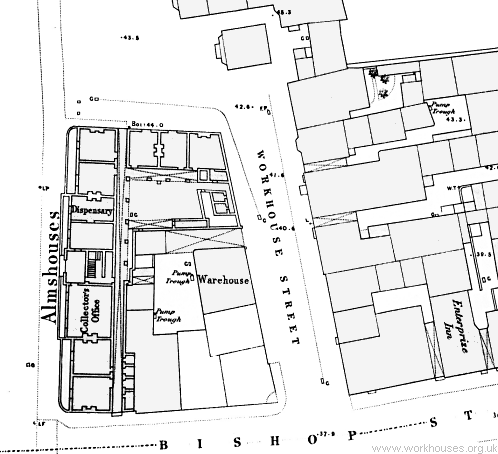
Stockton Workhouse Street site, 1855.
After 1834
Stockton Poor Law Union formally came into existence on 7th February 1837. Its operation was overseen by an elected Board of Guardians, 54 in number, representing its 41 constituent parishes and townships as listed below (figures in brackets indicate numbers of Guardians if more than one):
County of Durham
Parish of Stockton:
Stockton Town and Borough (8), East Hartburn, Preston.
Parish of Billingham:
Billingham, Cowpen Bewley, Newton Bewley, Wolviston, Egglescliffe, Aislaby, Newsham, Elton, Elwick Hall.
Parish of Greatham:
Greatham, Claxton.
Parish of Grindon:
Dalton Piercy, Elwick, Hart, Hartlepool (3), Longnewton, Norton (2), Throston, Thorp Bulmer, Whitton.
Parish of Redmarshall:
Carlton, Redmarshall.
Parish of Stranton:
Stranton, Brierton, Seaton Carew.
County of York — North Riding
Parish of Kirk Leavington:
Castle Leavington, Kirk Leavington, Low Worsall.
Parish of Middlesbrough:
Middlesbrough (3), Linthorpe.
Parish of Northallerton:
High Worsall, Stanton, Acklan, Ingleby Barwick, Maltby, Thornaby, Yarm (2).
Later Addition: Low Spennymoor (from 1894).
The population falling within the Union at the 1831 census had been 23,236 — with parishes ranging in size from Brierton (population 22) to Stockton itself (7,763). The average annual poor-rate expenditure for the period 1833-35 had been £7,375 or 6s.4d. per head of the population.
The new Stockton Union took over the existing Stockton parish workhouse. This was a very small workhouse, accommodating a maximum of 40 inmates and averaging about 20. The 1841 census records a total of 32 inmates, 18 female and 14 female, although the adult inmates were all female except for one man aged 60. In May 1847, a report by Assistant Poor law Commissioner HJ Hawley noted that the workhouse was in use as a fever hospital following an outbreak of illness amongst the vagrants. In addition, there were no receiving wards, school, or separate sick-ward, and poor supervision of inmates.
In 1849-51, a new workhouse was built at a nine-acre site on Portrack Lane, Stockton. It was designed by John and William Atkinson and could accommodate up to 260 inmates. Its layout is shown on the 1855 map below.
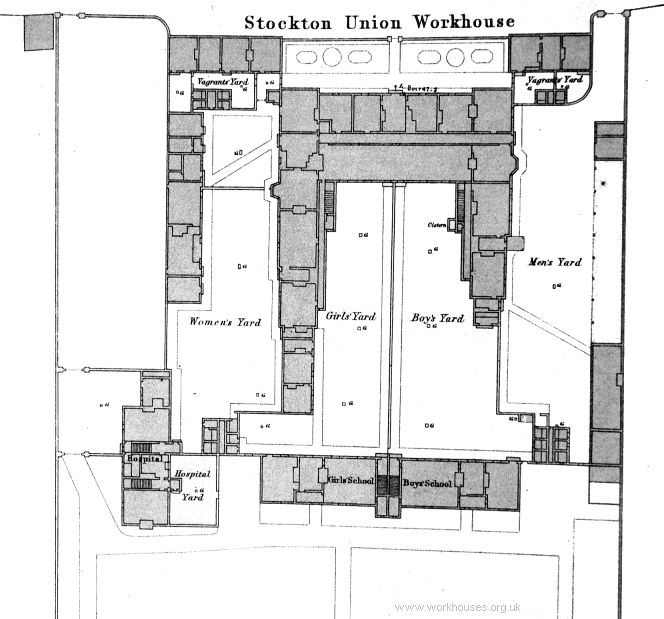
Stockton Portrack Lane site, 1855.
The initial buildings occupied only half of the site. The main entrance block at the north fronted onto Portrack Lane and contained the porter's lodge and Master's quarters. Vagrants' wards lay to each side of the entrance. The main building was originally a U-shaped layout and contained male accommodation at the east and female at the west. Children were housed in a separate block at the south of the site and an infirmary block stood at the south-west.
The buildings were later much expanded. A central wing containing a dining-hall was added at the rear of the entrance block. A further ward block was erected to the south, and a large new building for male patients was erected in 1868 at the south-east of the site. Another block, probably for isolation cases, was built to the south of the original infirmary. The workhouse location and layout are shown on the 1914 map below.
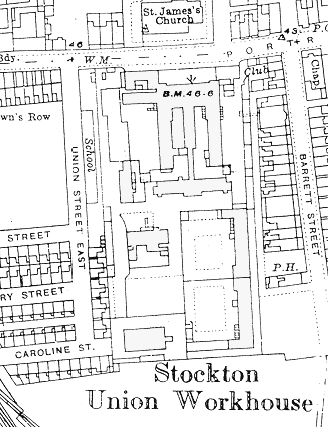
Stockton Portrack Lane site, 1914.
In 1875, part of the Stockton Union separated to form a new Middlesbrough Union. As part of the reorganisation, Stockton also lost the following townships to the Stokesley Union: Castle Leavington, Kirk Leavington, High Worsall, Low Worsall, Picton, and Yarm.
After 1930, the workhouse was renamed Stockton Public Assistance Institution, then in 1948 became Portrack Geriatric Hospital. In 1972 it was renamed St Anne's Hospital but closed in the 1970s. The buildings were then demolished.
Stockton Children's Homes / Cottage Homes
In the early 1900s, the union erected children's homes in Stockton — four in Hartington Road and four in Windsor Road, accommodating a total of 120.
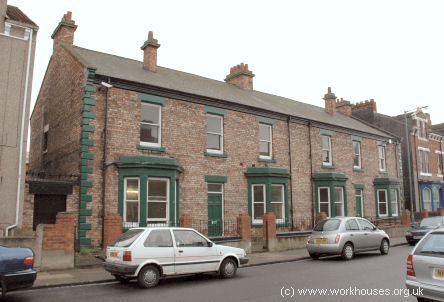
Stockton Hartington Road homes, 2005.
© Peter Higginbotham.
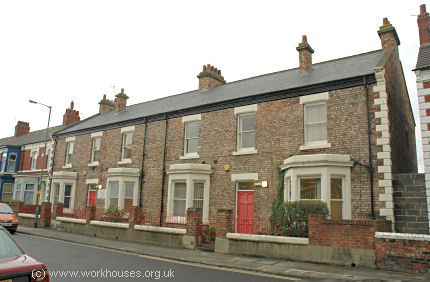
Stockton Hartington Road homes, 2005.
© Peter Higginbotham.
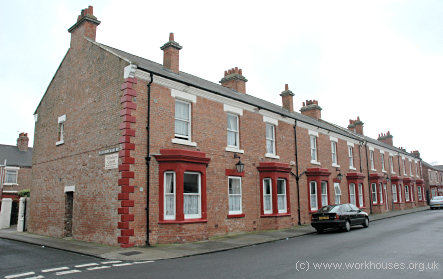
Stockton Windsor Road homes, 2005.
© Peter Higginbotham.
The Hartington Road houses are still owned by the local council — two are used for offices by social services and two were until recently being used as temporary accommodation for homeless families etc. The former Windsor Road homes are now used as a residential care establishment.
Staff
Inmates
Records
Note: many repositories impose a closure period of up to 100 years for records identifying individuals. Before travelling a long distance, always check that the records you want to consult will be available.
- Durham County Record Office, County Hall, Durham DH1 5UL. Holdings include: Guardians' minutes (1888-91, 1895-1930); Admissions and discharges (1915-32); Registers of children (1900-46); etc.
Bibliography
- Turner, JJ (1984) The Guisborough, Middlesbrough and Stockton-on-Tees Poor Law Union Workhouses 1837-c.1930.
Links
- None.
Unless otherwise indicated, this page () is copyright Peter Higginbotham. Contents may not be reproduced without permission.


